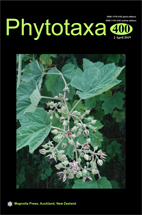Abstract
Heliconia montana and H. venusta are endemic to the tropical forests of the Central Andes. They belong to Heliconiaceae, a family recognized by the showy inflorescences of its members and hummingbird pollination. Both species were already established in 1983 but, just a few years later, the name H. montana was synonymized under the name H. venusta. Observations of populations of both species show that they differ by features evident in the field. A floral morphometric and a Principal Component analyses yielded also a clear cut distinction between H. montana and H. venusta. Therefore, Heliconia montana is reinstated here. The morphological features that differentiate H. montana and H. venusta are discussed, presented in a key, and illustrated with photographs.

